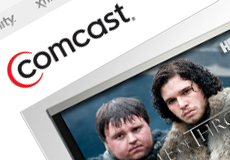Comcast Plans New Advertising Approach for Video On Demand
December 4, 2013
More television fans are turning to “catch up viewing” for their favorite TV shows. Although video on demand is increasing in popularity, TV outlets do not really benefit. Advertisers do not see a point in supporting TV episodes more than a few days after the initial air date. Comcast plans to experiment with allowing advertisers to place the same commercials on older streamed episodes of TV shows that are featured with current episodes.
 This maneuver “could help TV networks push back against ratings erosion caused by the DVR and assist cable companies in countering the availability of TV programming on video-streaming services like Hulu, Netflix and Amazon,” reports Variety.
This maneuver “could help TV networks push back against ratings erosion caused by the DVR and assist cable companies in countering the availability of TV programming on video-streaming services like Hulu, Netflix and Amazon,” reports Variety.
“This is directionally where we are heading,” said Matt Strauss, Comcast’s senior VP and general manager of video services.
“Comcast is partnering with Nielsen, and both are already working with NBCUniversal — the content conglomerate Comcast owns — and expect to work with others. CBS is among those on board, said David Poltrack, chief research officer of CBS,” explains Variety. The hope is “to offer a measurement — known as ‘ODCR’ or ‘on demand commercial ratings’ — of the broader audience making use of VOD in a way that is useful to the companies that sponsor TV programs.”
If Comcast’s plan is successful, it may be able to help TV networks, whose ratings are continually slipping.
“Since 2007, advertisers have paid only for viewers who watch the commercials that accompany their favorite program up to three days after the program first airs, a measure known in the industry as ‘C3,'” Variety explains. However, TV networks contend that they should be paid for more.
Comcast notes that 43 percent of on-demand viewing occurs within three days of a show’s original air date. “Using ODCR and adding the exact same ad load that accompanied the current episode to prior episodes, Comcast estimates 60 percent of viewing would take place within that three-day window that is the industry standard,” explains the article.
According to Nielsen, VOD is now available in 60 percent of U.S. TV households, up from just 37 percent five years ago. Comcast said 70 percent of its digital customers use video on demand.
“TV networks have managed to get cable distributors to block a viewer’s ability to fast forward past ads in exchange for VOD convenience — leaving media companies free to place fuller ad loads in VOD content than they have in other new venues like online streaming,” notes Variety.

No Comments Yet
You can be the first to comment!
Leave a comment
You must be logged in to post a comment.